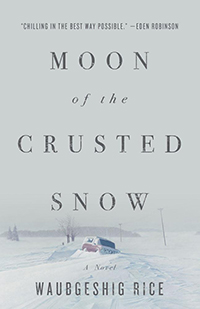Reviews
Fiction Review by Jamie Dopp
Waubgeshig Rice, Moon of the Crusted Snow (Toronto: ecw, 2018). Paperbound, 218 pp., $17.95.
 Moon of the Crusted Snow takes place in an isolated Ojibwe community in Northern Ontario. As the novel opens, the protagonist, Evan Whitesky, kills a moose, then performs ceremonies of gratitude to the animal for the life it has given. It is late fall. Snow is imminent. Evan heads home, where his wife and two children wait, and discovers that the lights are off. The electricity, cell phone service, and internet are all out. At first, these outages seem typical of the unreliable services received by the community. Days go by, however, and neither power nor communications are restored. Days turn into weeks and gradually it becomes clear that something apocalyptic has happened.
Moon of the Crusted Snow takes place in an isolated Ojibwe community in Northern Ontario. As the novel opens, the protagonist, Evan Whitesky, kills a moose, then performs ceremonies of gratitude to the animal for the life it has given. It is late fall. Snow is imminent. Evan heads home, where his wife and two children wait, and discovers that the lights are off. The electricity, cell phone service, and internet are all out. At first, these outages seem typical of the unreliable services received by the community. Days go by, however, and neither power nor communications are restored. Days turn into weeks and gradually it becomes clear that something apocalyptic has happened.
This novel offers a twist on the popular post-apocalyptic narrative, by focusing on an Indigenous community’s response to a worldwide calamity. The loss of modern technology divides the community between those who have retained traditional hunter-gatherer skills and those who have not. As winter deepens, and emergency food supplies dwindle, those less equipped to survive die off, and their frozen bodies are piled in a makeshift morgue. Division is increased by the arrival of Justin Scott, a white refugee, whose snowmobile trailer contains liquor and guns. Scott fancies himself a survivalist and tries to assume leadership of the community. At the climax, Scott is revealed to be a Windigo-like monster, with his eye on the corpses in the morgue. There is a confrontation. In the aftermath, the last of the community’s modern-style cohesion disappears, and a small, tight-knit group heads off into the forest to live a version of traditional Ojibwe life.
As the main arc of the story suggests, this novel uses its post-apocalyptic setting to celebrate the resilience of Indigenous people and to explore the challenges and possibilities of Indigenous resurgence. Along the way, Rice offers a well-crafted portrait of his community in a humble and direct style reminiscent of Richard Wagamese (though with a slightly broader comic touch). Overall, it is a moving and inspirational story.
While I admired this novel, I did find the post-apocalyptic aspect not entirely satisfying. The novel, rather in the manner of Cormac McCarthy’s The Road, does not explain the calamity that has led to the setting. This sharpens the focus on the reactions of the characters, which serves some good novelistic purposes. Even so, I found the lack of an explanation distracting. From a realist point of view, it’s hard to imagine a calamity of such magnitude that modern civilization collapses while leaving the novel’s Ojibwe community relatively untouched. The novel’s setting—an isolated community surrounded by a vast but undefined threat—has a Stephen-King-like feel to it at times. But does a King-like, non-realist or supernatural explanation blunt the novel’s message about Indigenous resurgence?
One of the recurring features of post-apocalyptic novels is that they suspend the messy complexity of everyday life. In the fulcrum of the apocalypse, success and failure are reduced to immediate challenges: survival, and, perhaps, the first tentative steps towards rebuilding. This allows for a kind of heroism not possible in everyday life, which accounts for the mix of dystopian and utopian elements found in so many classics of the genre. Moon of the Crusted Snow ends on a quasi-heroic note, when survivors head into the bush to establish a new version of traditional Ojibwe life. This offers a fantasy-like satisfaction consistent with the genre, but also suspends real-life complexity. The elimination of modern settler culture makes the return to Ojibwe life not a choice (since no alternative exists) but a necessity imposed by circumstance. Another way to read the post-apocalyptic aspect of the novel is as an expression of how difficult Indigenous resurgence is in present-day Canada. This is an important consideration (and somewhat counters my views above). Nevertheless, as I finished the book, I found myself wondering what would have happened at the end if the lights had come back on. How would the characters have applied what they learned, over the darkest winter ever, when modern culture was restored?
The first third of the novel offers an engaging portrait of the challenges Evan’s community encounter as Ojibwe people. Most of these challenges, however, are rendered moot by the arrival of the apocalypse. How to pass on Ojibwe traditions in the face of the distractions of modern life is no longer an issue when modern life no longer exists. Though I enjoyed the apocalyptic ride of Moon of the Crusted Snow, I’d be curious to read what Indigenous resurgence for people like Evan Whitesky would look like in real twenty-first-century Canada.
—Jamie Dopp









